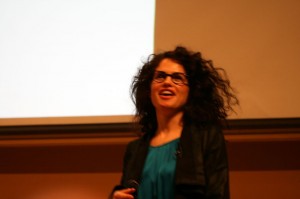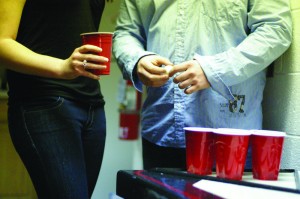By Courtney Bottazzi
Writer

Neri Oxman spoke to the campus community in Trout Auditorium about a new era and field called “material ecology.” In the concept of material ecology, the materials used in design should dictate form.
Explaining how she developed material ecology, Oxman described how her high school teacher wanted to decode humans through genetics and gradients.
“If you think about it, any living form, including human beings, responds to gradients,” Oxman said. If humans and nature respond to the pressure, temperature and atmosphere around us, she said, the structures we create can do the same.
One example she gave of this engineered implementation was the redesigning of a Coca-Cola can using the shape of a pinecone. With this new design, more soda cans can be stacked on shelves without the cans buckling under the combined weight.
As part of the University Forum series “Creativity: Out of the Box,” Oxman advised students not to settle into pre-established approaches to a project.
“Creativity is about being able to think beyond the media you’re using,” Oxman said. She said the first step of design should not be about geometrically creating a shape. “Form is conceived, then you must patch it up,” she said. She called this a “Crisis of Form.” Instead, the form should evolve out of the materials used, she said.
“All these amazing buildings are designed as geometry first, engineering second,” Oxman said, citing recent architectural examples such as the Bird’s Nest created for the Beijing Olympics. Oxman urged people to look at the material and environment to inspire the form.
“What I’m intrigued by is the middle ground that is between the natural world, the artificial world, and the tools we use,” Oxman said.
Oxman said this philosophy of design can be applied to many subfields, including medical device design. By working with people who suffer from carpal tunnel syndrome, Oxman, who has the condition herself, has been mapping a person’s pain to find which regions of a new medical device should have a distribution of hard and soft material. She hopes to find a flexibility to this device that has never been seen before.
Oxman’s ambitions and imagination know no limit. In a thousand years, she said, she hopes there will be the artificial construction of DNA. She proposed the idea of a chair that could potentially contain a baby’s DNA and grow simultaneously with the baby.
Ali Jones ’11 asked Oxman about her creative journey.
“I learned to live in peace with my schizophrenic approach to design,” Oxman said. “Do not fear ambiguity; this is the most interesting space for things to happen.”
Oxman was also asked what advice she would give to engineering students, especially first-year students.
“Hang stuff on your wall—photos, text—things that inspire you,” Oxman said. “Don’t be afraid to say, ‘This inspires me because it is beautiful.’”
Anne Sequeira ’12, a civil engineer, thought the idea of integrating material into design was refreshing.
“It wasn’t a secondary factor but a key component. It’s all one in itself; no definite separation of procedure,” Sequeira said.


